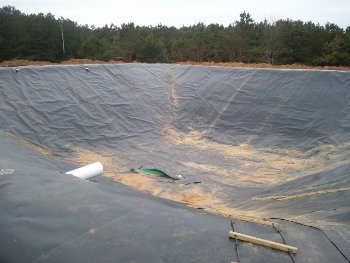 31 January 2010 – Officials with Santee Cooper, Environmental Fabrics Inc. (EFI) and Clemson University Monday announced the construction of a new renewable energy facility, the first of its kind in South Carolina, that will generate power from methane gas captured at a Williamsburg County farm and deliver it to electric customers on the Santee Cooper system.
31 January 2010 – Officials with Santee Cooper, Environmental Fabrics Inc. (EFI) and Clemson University Monday announced the construction of a new renewable energy facility, the first of its kind in South Carolina, that will generate power from methane gas captured at a Williamsburg County farm and deliver it to electric customers on the Santee Cooper system.
The 180-kilowatt Burrows Hall Renewable Energy Facility, a true public-private partnership with many benefits across the state, is expected to begin generating renewable energy for the grid early this summer — enough power for approximately 90 average South Carolina homes.
The project also involves Santee Electric Cooperative, the South Carolina Energy Office and the South Carolina Department of Agriculture.
The announcement comes four years after Duffy Connolly, owner of Burrows Hall Farm, approached Santee Cooper with an idea of building an anaerobic digester that could capture methane gas, naturally produced on his hog farm, and turn that methane into a fuel source for electricity.
They turned to Clemson University’s South Carolina Institute for Energy Studies for assistance in defining and implementing the project, using a grant administered by the South Carolina Energy Office and funded by the South Carolina Department of Agriculture. The Institute for Energy Studies evaluated more than 20 different companies and approaches before recommending EFI.
EFI, a Gaston-based firm, was chosen to design and build the digester. EFI has been granted the necessary permits and construction is under way. Upon completion, EFI will own and operate the digester. Santee Cooper has contracted to purchase the power, which Santee Electric Cooperative will distribute from Burrows Hall to the Santee Cooper transmission network.
Methane gas is a greenhouse gas 21 times more potent than carbon dioxide, and so the digester represents a significant environmental benefit with potential applications in agricultural settings across the state. The state’s economy benefits because the venture, utilizing 100 percent South Carolina resources, will provide cost-effective renewable energy, reduce the need for traditional fuel sources, and outline the potential implementation of similar systems across the state.
“The S.C. Energy Office was glad to work in conjunction with Clemson University and the S.C. Department of Agriculture to facilitate a project that shows the diverse potential for renewable applications in South Carolina,” said Ashlie Lancaster, S.C. Energy Office’s director. “This project taps into indigenous energy resources in our state which not only creates jobs but also helps to reduce harmful emissions.”
South Carolina Commissioner of Agriculture Hugh Weathers said, “The renewable energy grant program was established for this very kind of purpose, to turn waste products in agriculture or from other sources into energy and thus reduce the amount of waste that must be disposed of in less-productive ways.”
“This project is an excellent example of how we can take something that we consider waste today, and turn it into a valuable resource,” Robert Leitner, director of the Institute for Energy Studies, said. “Numerous other opportunities abound in the state, including both solid wastes and waste heat from our power plants, factories and cars. SCIES is committed to turning these unused waste streams into low-cost, reliable sources of power.”
Connolly said: “We are very excited about this project and look forward to integrating it into our operation. It is our hope and expectation that this new facility will provide us with one more tool to help enhance our farm’s operation as we continue our efforts to become more efficient and environmentally friendly.”
“Santee Cooper is South Carolina’s renewable energy leader, with 197 megawatts of renewable generation already online or under contract to come online in the next couple of years,” said Marc Tye, Santee Cooper’s vice president of conservation and renewable energy. “Our electricity includes power generated from landfill biogas, forest-waste biomass, solar and wind, and now we can add agricultural biogas to the lineup.”
Dennis Shanklin, CEO of Environmental Fabrics Inc. is “pleased to be bringing our expertise and experience with digesters to our home state. This project is a first in the Southeast, but with the collaboration of those involved and progression to environmental awareness in the political arena, we look forward to similar opportunities in the future to benefit our state.”
ABOUT THE PROJECT PARTNERS
The South Carolina Institute for Energy Studies at Clemson University was founded in 1982 by act of the South Carolina Legislature to address energy issues in the state and the nation. It focuses on the development and implementation of new power generation and energy efficiency technologies. For more information, visit www.clemson.edu/scies.
Santee Cooper is South Carolina’s state-owned electric and water utility and the state’s largest power producer. The ultimate source of electricity for 2 million South Carolinians, Santee Cooper is dedicated to being the state’s leading resource for improving the quality of life for the people of South Carolina. For more information, visit www.santeecooper.com.
Environmental Fabrics Inc. (EFI) is an environmental construction firm located in the Columbia area for almost 20 years, specializing in Geosynthetic Installation, Biogas Management and Digester Design, Construction and Operation. EFI has installed more than 600 digesters worldwide, with more than 250 of those throughout the United States. Its website is www.environmentalfabrics.com.











